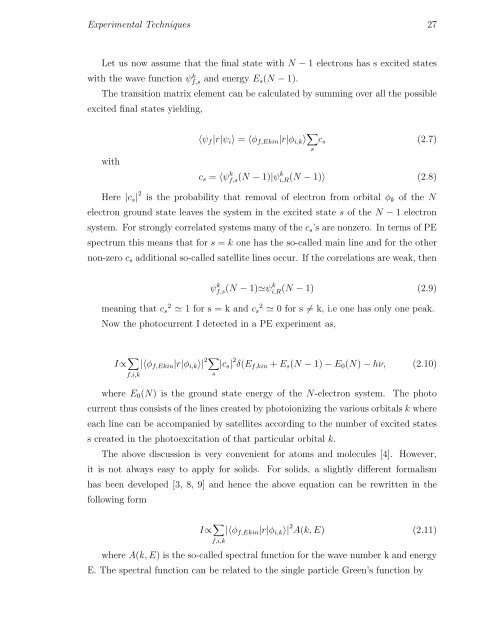PHYS07200604007 Manas Kumar Dala - Homi Bhabha National ...
PHYS07200604007 Manas Kumar Dala - Homi Bhabha National ...
PHYS07200604007 Manas Kumar Dala - Homi Bhabha National ...
You also want an ePaper? Increase the reach of your titles
YUMPU automatically turns print PDFs into web optimized ePapers that Google loves.
Experimental Techniques 27<br />
Let us now assume that the final state with N − 1 electrons has s excited states<br />
with the wave function ψf,s k and energy E s (N − 1).<br />
The transition matrix element can be calculated by summing over all the possible<br />
excited final states yielding,<br />
〈ψ f |r|ψ i 〉 = 〈φ f,Ekin |r|φ i,k 〉 ∑ s<br />
c s (2.7)<br />
with<br />
c s = 〈ψf,s k (N − 1)|ψk i,R (N − 1)〉 (2.8)<br />
Here |c s | 2 is the probability that removal of electron from orbital φ k of the N<br />
electron ground state leaves the system in the excited state s of the N − 1 electron<br />
system. For strongly correlated systems many of the c s ’s are nonzero. In terms of PE<br />
spectrum this means that for s = k one has the so-called main line and for the other<br />
non-zero c s additional so-called satellite lines occur. If the correlations are weak, then<br />
ψ k f,s(N − 1)≃ψ k i,R(N − 1) (2.9)<br />
meaning that c s 2 ≃ 1 for s = k and c s 2 ≃ 0 for s ≠ k, i.e one has only one peak.<br />
Now the photocurrent I detected in a PE experiment as,<br />
I∝ ∑ |〈φ f,Ekin |r|φ i,k 〉| 2∑<br />
f,i,k<br />
s<br />
|c s | 2 δ(E f,kin + E s (N − 1) − E 0 (N) − hν, (2.10)<br />
where E 0 (N) is the ground state energy of the N-electron system. The photo<br />
current thus consists of the lines created by photoionizing the various orbitals k where<br />
each line can be accompanied by satellites according to the number of excited states<br />
s created in the photoexcitation of that particular orbital k.<br />
The above discussion is very convenient for atoms and molecules [4]. However,<br />
it is not always easy to apply for solids. For solids, a slightly different formalism<br />
has been developed [3, 8, 9] and hence the above equation can be rewritten in the<br />
following form<br />
I∝ ∑ f,i,k|〈φ f,Ekin |r|φ i,k 〉| 2 A(k, E) (2.11)<br />
where A(k, E) is the so-called spectral function for the wave number k and energy<br />
E. The spectral function can be related to the single particle Green’s function by
















